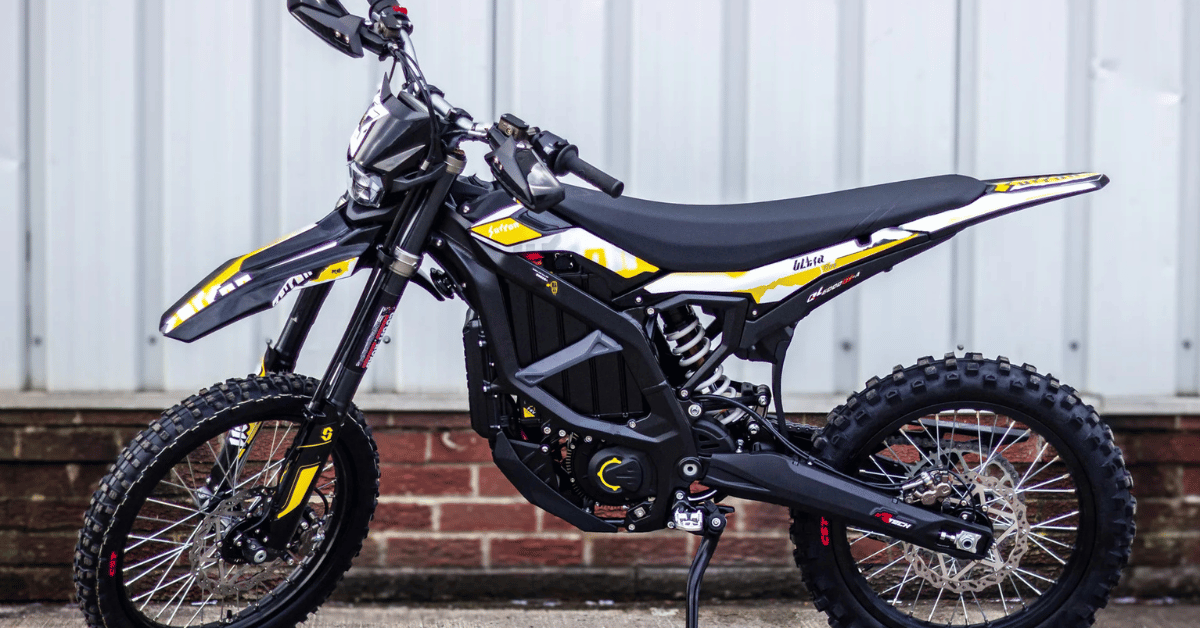The Surron Ultra Bee is more than just another electric dirt bike. It represents a critical turning point in how we think about off-road mobility—merging performance, sustainability, and modern technology into a single machine. Within its sleek frame lies the potential to redefine the electric two-wheeler category. For those searching for in-depth information, this guide covers every essential detail—from technical specifications to rider experiences, from market position to long-term potential. By the end, you will understand why the Ultra Bee is regarded as one of the most compelling electric motorcycles available today. In a world shifting toward cleaner transportation, the Ultra Bee not only delivers on environmental promises but also offers raw power and agility comparable to—or even surpassing—many traditional combustion dirt bikes. With its advanced engineering and intuitive design, Surron has positioned the Ultra Bee as a leader for off-road enthusiasts and eco-conscious riders alike.
The importance of such a model in 2025 cannot be understated. Riders no longer have to choose between high performance and sustainability. The Ultra Bee delivers both, proving that electric doesn’t have to mean compromise. In fact, it offers advantages that fuel-powered bikes cannot match—instant torque, near-silent operation, reduced maintenance, and remarkable adaptability for different terrains. From steep hill climbs to technical trails, the Ultra Bee thrives in environments that test a rider’s skill. This article will take you through every element—performance data, rider impressions, engineering insights, and how it compares to other competitors in the market. Whether you are considering buying one or simply curious about the latest in electric off-road innovation, this is the most comprehensive, up-to-date exploration you’ll find.
The Design Philosophy Behind the Surron Ultra Bee
When the Ultra Bee was conceived, Surron’s engineers had one guiding principle: create an electric dirt bike that performs like a gas-powered one without any of the drawbacks. This required a delicate balance between lightweight construction, robust battery capacity, and powerful torque delivery. The frame was designed to be both rigid and agile, using high-strength aluminum alloys that reduce weight while retaining durability. This allows the Ultra Bee to maintain exceptional maneuverability on demanding trails, yet still feel stable during high-speed runs.
The design also considers rider ergonomics. With adjustable suspension travel and handlebar positioning, it accommodates different riding styles, from aggressive motocross postures to relaxed trail cruising. Surron integrated a minimalist, functional aesthetic—no unnecessary plastics or bulk, every component serving a specific purpose. The result is a machine that feels engineered for real-world riding rather than showroom appeal.
A key design highlight is the integration of the battery pack into the frame for a lower center of gravity, improving stability on uneven ground. The battery compartment is sealed to protect against dust, mud, and water intrusion, making the Ultra Bee capable of enduring harsh environments without compromise. The blend of minimalism and ruggedness reflects the ethos of modern electric mobility: efficiency, performance, and sustainability all working together.
Technical Specifications and Performance
Below is a table outlining the key specifications of the Surron Ultra Bee for 2025:
| Specification | Details |
|---|---|
| Motor Type | High-efficiency permanent magnet synchronous motor |
| Peak Power | Approx. 12.5 kW |
| Torque | 440 Nm at the rear wheel |
| Battery Capacity | 74V 55Ah lithium-ion |
| Range (Eco Mode) | Up to 140 km |
| Range (Sport Mode) | Approx. 90 km |
| Charging Time | 3.5 to 4 hours |
| Top Speed | Around 90 km/h |
| Weight | 85 kg (without rider) |
| Suspension | Fully adjustable front and rear |
| Brakes | Hydraulic disc front and rear |
| Frame Material | Forged aluminum alloy |
These numbers tell part of the story. The Ultra Bee delivers instant torque—a defining characteristic of electric propulsion—allowing riders to launch from a standstill with an immediacy that gasoline bikes cannot match. This responsiveness is particularly advantageous on technical climbs where precise throttle control is key. In addition, the near-silent operation allows riders to blend with their environment, making wildlife encounters less disruptive and the riding experience more immersive.
Battery Technology and Charging Innovation
The battery system of the Ultra Bee is one of its defining features. Surron invested heavily in energy density improvements, enabling a smaller battery pack to deliver higher performance. The 74V 55Ah lithium-ion battery offers a solid balance between range and weight. Designed for rapid discharge, it ensures consistent power output even under high-load situations like steep inclines or sand riding.
The charging system supports both standard home outlet charging and optional high-speed charging units. For most riders, a standard charge from empty to full takes about 3.5 to 4 hours. In comparison to other electric off-road bikes, this is competitive and practical for day-to-day use. The battery is also removable, allowing for quick swaps during extended riding sessions—a feature that significantly extends riding time for professional or adventure riders.
Thermal management is another area where the Ultra Bee shines. The battery housing integrates passive cooling channels that help regulate temperature during heavy use, reducing performance drop-off. Riders in hot climates benefit from stable output, even after prolonged riding in demanding conditions.
Riding Dynamics and Terrain Adaptability
One of the greatest strengths of the Ultra Bee is how it adapts to different terrains. Riders report that the adjustable suspension is a game-changer, allowing them to fine-tune the bike for rocky trails, soft sand, or hard-packed dirt. The low weight of just 85 kg makes it remarkably nimble—ideal for quick direction changes in tight forest paths or technical sections.
Torque delivery is linear and controllable, giving riders confidence when navigating tricky obstacles. The regenerative braking system also contributes to control, especially on steep descents where it helps maintain a stable pace without over-reliance on the brake levers. In wet or muddy conditions, the sealed electronics and traction-friendly tires keep performance consistent.
The Ultra Bee offers multiple riding modes, including Eco, Sport, and customizable settings for power output and throttle sensitivity. This flexibility means a single bike can serve both as a long-range explorer and a short-distance performance machine.
Market Position and Competitive Comparison
In the electric dirt bike market, the Ultra Bee sits in a competitive position between lightweight trail models and high-performance electric motocross bikes. It offers enough power for spirited riding while maintaining the efficiency and agility of smaller models. The table below compares the Ultra Bee with two notable competitors:
| Model | Peak Power | Range (Sport) | Weight | Price Range |
|---|---|---|---|---|
| Surron Ultra Bee | 12.5 kW | 90 km | 85 kg | Mid-tier premium |
| KTM Freeride E-XC | 18 kW | 80 km | 111 kg | Higher premium |
| Talaria Sting R | 8.5 kW | 100 km | 95 kg | Mid-range |
This positioning appeals to riders who want serious off-road capability without moving into the heavier, more expensive segment of electric motorcycles. It’s powerful enough for motocross-style riding but light and manageable for casual trail enthusiasts.
Expert Insights and Rider Impressions
Electric mobility experts have praised the Ultra Bee’s balance of power and efficiency. As electric motorcycle analyst Darren Hensley notes:
“The Ultra Bee demonstrates that electric dirt bikes are no longer niche toys—they’re legitimate tools for serious riders.”
Riders also highlight the Ultra Bee’s reliability and ease of maintenance. Without the complexity of an internal combustion engine, servicing is reduced to brake checks, tire changes, and occasional suspension tuning. This translates into more riding time and less downtime for repairs.
Professional off-road rider Kendra Walsh comments:
“It’s the kind of bike that makes you rethink your riding style. You can attack climbs with confidence, knowing the torque is instant and predictable.”
The Future of the Surron Ultra Bee
The 2025 Ultra Bee is positioned to play a major role in shaping perceptions of electric off-road riding. Its combination of affordability, capability, and eco-conscious design makes it attractive to a wide range of riders. As battery technology improves, future iterations will likely offer even greater range and faster charging, potentially closing the last gaps between electric and gasoline bikes in terms of endurance.
Industry trends also suggest that more trail networks and motocross facilities will accommodate electric bikes exclusively in the coming years. This will create a supportive ecosystem for models like the Ultra Bee, ensuring long-term relevance.
Conclusion
The Surron Ultra Bee is not just another entrant in the electric dirt bike scene—it is a thoughtfully engineered, performance-oriented machine that delivers on the promise of electric mobility. Its lightweight frame, powerful torque, adaptable suspension, and reliable battery system make it a versatile choice for a wide range of riders. With environmental concerns pushing the motorcycle industry toward cleaner solutions, the Ultra Bee stands as proof that electric power can be thrilling, capable, and sustainable all at once.
As the electric off-road market matures, the Ultra Bee’s combination of performance and practicality may well set the benchmark for others to follow. Whether you are a competitive rider looking for an edge, or an enthusiast seeking adventure without emissions, this bike offers a compelling and future-ready solution. In the words of rider and early adopter Liam Morgan:
“Once you ride it, there’s no going back—it’s the purest form of off-road fun I’ve experienced in years.”
FAQs
1. What is the Surron Ultra Bee best suited for?
The Ultra Bee is designed for off-road use, excelling in trail riding, motocross-style tracks, and technical terrain. Its lightweight frame and powerful torque make it ideal for steep climbs, rocky paths, and tight forest routes. Riders looking for a balance between high performance and agility will find it especially appealing. While it can handle casual riding, its engineering clearly caters to those who want serious off-road capability without the complexity of a gasoline engine.
2. How long does the battery last during typical use?
Battery life depends on riding style and terrain. In Eco Mode, you can expect up to 140 km on a full charge. In Sport Mode, which delivers maximum performance, the range drops to about 90 km. Factors such as steep inclines, aggressive acceleration, and heavy loads can reduce range, while smoother riding extends it.
3. Can the Surron Ultra Bee be charged from a regular home outlet?
Yes, it can. The standard charger plugs into a regular household outlet, taking roughly 3.5 to 4 hours to fully charge the battery. For those who need faster turnaround, an optional high-speed charger is available, cutting the charge time significantly. Riders who want continuous riding can take advantage of the removable battery design, swapping in a fully charged pack when needed.
4. Is the Surron Ultra Bee suitable for beginners?
While it is accessible for newer riders, the Ultra Bee’s power and quick torque delivery require some skill to manage. Beginners who start in Eco Mode will have a smoother learning curve, while more experienced riders can unleash its full potential in Sport Mode. Its lightweight design also makes it less intimidating than heavier electric motorcycles.
5. How does it compare to gasoline-powered dirt bikes?
The Ultra Bee matches or surpasses many gasoline dirt bikes in acceleration, torque, and agility. It offers instant throttle response without gear shifting, making it easier to control in technical terrain. Maintenance is significantly simpler since there’s no oil changes, carburetor adjustments, or exhaust issues. The trade-off is a shorter range than a full fuel tank, though battery technology continues to improve.











